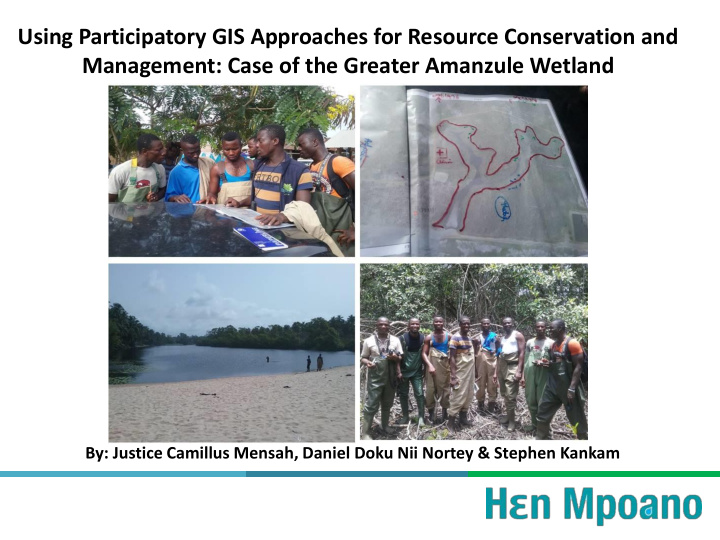



Using Participatory GIS Approaches for Resource Conservation and Management: Case of the Greater Amanzule Wetland By: Justice Camillus Mensah, Daniel Doku Nii Nortey & Stephen Kankam
Outline • Introduction • Goal/Objectives • HM Approach • Results • Impacts/Observation • Conclusions • Recommendations
Introduction • Participatory GIS is one of the most effective ways of mapping wetland resources • In Ghana high resolution multispectral imagery for local scale mapping and planning is limited
Goal/Objectives • To use participatory GIS as a tool for community participation in the conservation, planning and management of mangrove ecosystems associated with the Greater Amanzule Wetland landscape.
Objectives • Map the current extent of mangroves and identify degraded mangroves within the GAW • Identify possible management actions • Pilot mangrove restoration in selected communities
STUDY AREA
HM Approach-Mangrove Mapping • Visual interpretation of 2005 orthophotos • Google images and GPS survey points for validation
HM Approach- Management Action • Formation and training of CCCs and DCCs • Consultation meetings with Traditional authorities • Development of management actions with communities • Implementation of specific community resource management actions
HM Approach- Mangrove Restoration • Pilot Communities- Sanwoma, Anyanzini, Metika
Results 140 MANGROVES DEGRADED MANGROVES 120 100 Area (Hectares) 80 60 40 20 0 Communities • 688.75 hectares of mangroves mapped • 160 hectares of mangroves degraded
Results • Mangrove nurseries established voluntarily and field replanting activities initiated • 21.30 hectares of degraded mangrove areas restored • Mangrove harvesters now champions of mangrove replanting and conservation efforts
Results
Impacts/Observation • Increase in shrimps and periwinkles harvest • Increase in sizes and quantities of Chrysichthys nigrodidtatus harvested
Conclusions • Participatory approach is a cost- effective approach to wetland conservation and management planning and has proven to be a successful tool for conservation and management • Mapping products generated for each communities to aid in communication and identification of specific management actions • The use of participatory approach in natural resource mapping and management is an effect tool in the absence of local scale high resolution imagery.
Recommendations • Increase restoration efforts to restore degraded sites • Development of local norms or by-laws to govern the exploitation of the wetland resources
THANK YOU ✓ Coastal Sustainable Landscapes Project (CSLP) ✓ Sustainable Fisheries Management Project
Recommend
More recommend